|
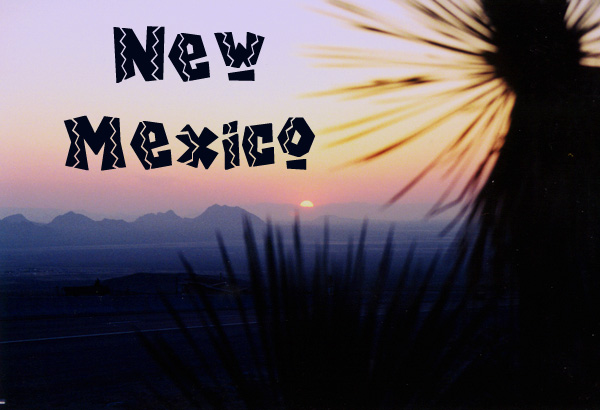
Click on the
thumbnails to see the picture full size.
Use the
"back" button in your browser to return to this page
This page
load SLOWLY because of all the thumbnails.
 |
 |
 |
 |
 If you want the best salsa in the world, you got to
taste Greg's Salsa. WOW! |
| The desert and mountains around Las Cruces make for a
beautiful vista. Unfortunately the day we went for a hike at the Dripping Springs,
they were doing a controlled burn. |
Gila River Hikes
We went for 2 six hour hikes
along the Gila (pronounced hee-la) River. It was 100�, but the low humidity made it very pleasant. Crossing the Gila River 25 times helped
us stay cool, too.
The rock formations
along the river made every bend in the river spectacular and unique.
The path was marked by
piles of stone on the river banks. A spring flood had knocked a lot of them down, so
upon discovering the purpose of the rock piles (we lost the path early on, before we knew
what they were for) mom found great pleasure in building missing piles and adding onto
existing ones. I think we can accurately say that she had a hand in every marker on
those trails! |
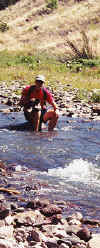 |
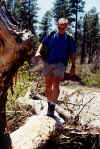 |
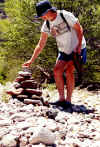 |
 |
 |
 |
 |
 |
 |
 |
| Gila Cliff Dwillings The ancient dwelling were actually only occupied 2 or 3
generations. There was an area in the back of the cave that was obviously raised and
smothed out by clay imported from the river. They think that it was an area for the
young children to play. There was dark soot all along the ceiling that predated the
cliffdwelling by over 500 years. |
 |
 |
 |
 |
|
 |
 |
|
|
|
Camping
We camped near the Gila River
hot springs. Each camp site had its own spiggot of steaming HOT water. Inspite
of the 100�
days, the temperature at night got down to upper 30's. Each evening we filled all of
our water containers with the hot spring water and by morning we had ice-cold, fresh spring water. |
 |
 |
 |
 |
|
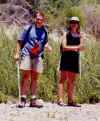 |
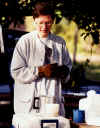 |
 |
|
|
| White Sands Desert Most of the desert is off
limits, as it is part of the U.S. government's missle range. But a small part is set
aside as a National park. They keep the "ice-packed, snow-covered" looking
roads open with snow plows! Children bring sleds to slide down the dunes.
It is a rare desert in
the way it is formed. About 20 miles to the west is a small group of mountains.
The runoff from these mountains flow into two dry lakes and quickly evaporate.
The runoff contains a great deal of gypson, which is obviously water solluble.
When the water evaporates, it leaves large crystals. The wind coming off the
mountains break up the crystals into a fine sand which we see in the dunes of the desert.
|
 Mom and Shelly sliding down a dune. |
 A beetle stands on his head to detect water.
What can I say, you gotta enjoy wild life when you can find it! A beetle stands on his head to detect water.
What can I say, you gotta enjoy wild life when you can find it! |
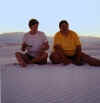 Inge and Deb |
 Snow?? not on this 100� day! |
 |
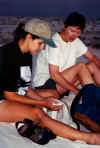 Inge and Michelle |
 Inge and Michelle |
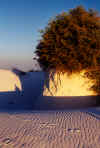 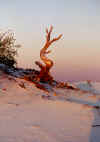 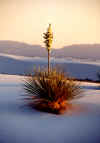 Plants are constantly racing the
dunes. The dunes move about 14 feet per year. When the Yuka plant finds itself
in the shaddow of a dune, it start to grow fast and furriously. Will the dune move
and cover it, or will the plant grow tall enough to keep its stalk above the sand?
The only problem is, once the dune has moved past, and the yukka has managed to grow fast
enought, the plant is too tall to support itself, so it break off and dies. The
plant on the left has managed to harden the sand around its root so that as the dune is
passing, it can hold its own.
|

|






































